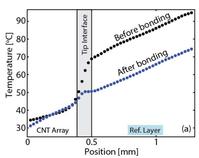Reactive Metal Bonding of Carbon Nanotube Arrays for Thermal Interface Applications
Reactive Metal Bonding of Carbon Nanotube Arrays for Thermal Interface Applications
| Event Date: | December 18, 2014 |
|---|---|
| Authors: | Michael T. Barako, Yuan Gao, Yoonjin Won, Amy Marconnet, Mehdi Asheghi, and Kenneth E. Goodson |
| Journal: | IEEE Transactions on Components, Packaging and Manufacturing Technology |
| Paper URL: | Link to Full Text |
Vertically aligned carbon nanotube (CNT) arrays can offer an attractive combination of high thermal conductance and mechanical compliance for thermal interface applications. These arrays require a reliable, thermally conductive bonding technique to enable integration into devices. This paper examines the use of a reactive metal bonding layer to attach and transfer CNT arrays to metal-coated substrates, and the thermal performance is compared with CNT arrays bonded with indium solder. Infrared microscopy is used to simultaneously measure the intrinsic thermal conductivity of the CNT array and the thermal boundary resistance of both the bonded and growth CNT interfaces over a range of applied compressive stresses. A coarse-grained molecular simulation is used to model the effects of compressive pressure on the CNT array thermal conductivity. Reactive metal bonding reduces the thermal boundary resistance to as low as 27 mm² · K · W¹, which is more than an order of magnitude less than the nonbonded contact.

